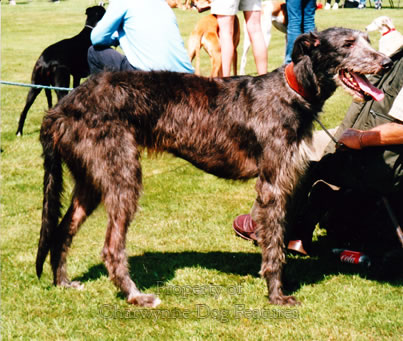1033 SIGHTHOUNDS LOSING GROUND
SIGHTHOUNDS LOSING GROUND
by David Hancock

Throughout the 20th century as the relentless expansion of towns and the demands of human needs manifested themselves, sporting dogs suffered, with the sighthound group perhaps the greatest loser. On mainland Europe, coursing was increasingly banned in the 19th century, but in Africa, Arabia and the Near East, changes in the nomadic way of life, agriculture and an ever-increasing urban sprawl, has seen the use of fast hunting dogs wane. Sadly too, in the show rings of the western world and in North America, the sighthound breeds have lost favour. In the UK in 2016, these breeds were showing falling numbers: only 1 Ibizan Hound was newly registered; just 100 Borzois were registered; only 209 Deerhounds were newly registered, only 41 Greyhounds, 256 Irish Wolfhounds and 139 Salukis. Of the newly-introduced breeds, the Cirneco dell'Etna had 14 registered, the Azawakh only 2, the Pharaoh Hound 15, the Sloughi had none. Admittedly the Whippet attracted over 3,000 but they were nearly all household pets rather than coursing dogs. At this rate, this group of dogs could actually disappear from the sporting world in the not-so-distant future, and that would be a sad loss. 
We should be thankful for such pot-fillers, celebrate the speedsters of the dog world, and express our admiration of their astonishing athleticism, remarkable hunting skills and sheer stylishness, right across the world. We should be lauding the story of the ‘canine cursorials’ – dogs having limbs adapted for running, that find their prey in open country and hunt it using great pace, often over considerable distances. It is no surprise therefore to find their most effective use in deserts, on steppes and prairies or level rocky terrain, from Syria and Iraq to Afghanistan and Russia. They were valued by hunters from ancient Egypt and classical Greece, then in turn, by tsars, sheikhs and western noblemen. Arrian, the Greek historian, wrote in 124AD: “I myself have bred a hound whose eyes are the greyest of grey. A swift, hard-working, courageous, sound-footed dog, and she proves a match at any time for four hares. She is, moreover, most gentle and kindly-affectioned…” That is a timeless description of the sighthound function and nature.



The Devonshire Hunting Tapestries of the early 15th century, in the collections of the Victoria and Albert Museum, vividly display the sheer pageantry of the hunting scenes of those times, featuring hounds and hawks – with the hounds mainly consisting of the Greyhound type, illustrating the high value in the hunting field of these hounds at that time. Such scenes typified the hunting scene right across Europe and western Asia in the 15th century - the style of the pageantry may have differed but the significant employment of sighthounds and their immense value to man at that time is evident. The tapestries indicate the wide range of quarry pursued by such hounds. They illustrate too the close companionship of man and dog in the hunt.
It is not surprising that, unlike some types of dog at the mercy of human whim, the sighthounds have retained their timeless type. An immediate similarity can be detected between, say, Durer’s sketch of a small sighthound of around 1500 and Augustus John’s portrayal of a Whippet in 1948. The hounds depicted in Paolo Uccello’s Hunt in the Forest of the mid-1400s and in Piero della Francesca’s Portrait of Sigismondo Malatesta of 1451 could have featured in Franz Luycx’s portrayal of the Kaiserin Eleonora Gonzaga of 1651. The anatomy of the sighthound has been shaped by function and decided by function. Changes in hunting itself may have seriously lessened the sighthound role and their use on the racing tracks is falling too, these breeds are in crisis.


In his Of English Dogs published in 1576, Dr Caius mentions two types of hunting dogs: ‘One which rouseth the beast, and continueth the chase. Another which springeth the bird, and bewrayeth the flight by pursuit.’ My worry concerns the former. He further subdivided such hunting dogs into five functional categories: ‘The first in perfect smelling, the second in quick spying, the third in swiftness and quickness, the fourth in smelling and nimbleness and the fifth in subtlety and deceitfulness’. I worry about the second and third categories, the type relying on sight and speed. The athleticism of the sighthound breeds embraces sprinting, hurdling and middle-distance running; they are canine athletes that also clear obstacles and turn at great speed, sometimes facing formidably-fanged or dangerously-antlered quarry. They thoroughly merit our admiration and totally deserve our patronage in these difficult days for hunting dogs of every type.

It could be argued that for sportsmen in Britain, the wide varieties of lurcher have replaced many of the breeds losing popularity, with the Deerhound lurcher, the Whippet hybrid and the bull lurcher offering the span once provided by the pure-bred hounds. I have seen lurchers so like the Pharaoh Hound, the Cirneco dell'Etna, the Saluki, the Ibizan Hound, the Sloughi and the Deerhound that I have had to check their breeding to correctly identify them. It is likely that the look-a-like lurchers are healthier dogs too. For me, that dimension is some consolation for the loss of diversity in sighthound breeds. Sadly as closed gene pools reap their harvest in the registered breeds, that, at least, is some solace.